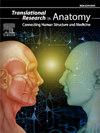在胎儿生长受限的豚鼠模型中,通过重复纳米颗粒介导的IGF1治疗来纠正异常胎盘结构
Q3 Medicine
引用次数: 0
摘要
胎儿生长受限(FGR)最常见的原因是胎盘功能不全。目前尚无治疗胎盘功能不全或FGR的方法,唯一的干预措施是医源性早产。我们之前已经在母体营养限制(MNR) FGR豚鼠模型中证明了重复胎盘纳米颗粒介导的胰岛素样1生长因子(IGF1)治疗在提高胎盘效率(增加胎胎盘重量比)和纠正胎儿生长方面的有效性。我们假设,我们和其他人之前在FGR/MNR胎盘中发现的胎盘结构变化(交换面积减少,血管结构改变)导致胎盘功能缺陷,通过我们重复的纳米粒子介导的hIGF1治疗可以减轻胎盘功能缺陷。方法在母体营养限制(MNR)豚鼠模型中,我们研究了3次重复胎盘内注射纳米颗粒介导的hIGF1后胎盘的结构重塑,这可能是已发表的胎盘效率和胎儿生长改善的基础。我们利用免疫组织化学和ct检查了胎盘结构的微血管和大血管变化,以确定FGR和治疗的变化。结果经sham处理的MNR胎盘微血管迷路交换区紊乱,胎盘毛细血管数量减少,胎盘大血管体积增加。然而,重复的纳米颗粒介导的hIGF1处理导致交换面积的改善,胎盘毛细血管数量和大血管体积正常化。结论:重复的纳米颗粒介导的hIGF1传递纠正了FGR期间胎盘结构的异常,胎盘功能不全可能导致胎儿气体交换和营养物质转移的改善,从而恢复胎儿的生长。本文章由计算机程序翻译,如有差异,请以英文原文为准。
Aberrant placental structure is corrected with repeated nanoparticle-mediated IGF1 treatments in a Guinea pig model of fetal growth restriction
Background
Fetal growth restriction (FGR) is most commonly due to placental insufficiency. There are currently no treatments for placental insufficiency or FGR, and the only intervention is iatrogenic pre-term delivery. We have previously shown efficacy of repeated placental nanoparticle-mediated insulin-like 1 growth factor (IGF1) treatment in improving placental efficiency (increased fetal-placental weight ratio) and correcting fetal growth in a maternal nutrient restriction (MNR) guinea pig model of FGR. We hypothesize placenta structural changes (reduced exchange area, altered vascular structure) that we and others have previously shown in the FGR/MNR placenta which lead to deficits in placental function are mitigated by our repeated nanoparticle-mediated hIGF1 treatment.
Methods
Here we investigate the structural remodeling of the placenta in a maternal nutrient restriction (MNR) guinea pig model following 3 repeated intraplacental injections of nanoparticle-mediated hIGF1 that may underpin the published improvements in placental efficiency and fetal growth. Using immunohistochemistry and Dice-CT we investigated the micro- and macrovasculature changes of the placenta structure to identify changes in FGR and treatment.
Results
Sham-treated MNR placentas displayed disorganized microvasculature labyrinthine exchange areas with a reduction in placental capillary number and an increase in the volume of the placenta macrovasculature. Repeated nanoparticle-mediated hIGF1 treatment, however, resulted in an improved exchange area with normalized placental capillary number and macrovasculature volume.
Conclusions
This data demonstrates repeated nanoparticle-mediated hIGF1 delivery corrects aberrant placenta structure during FGR and placental insufficiency likely leading to improved gas exchange and transfer of nutrients to the fetus restoring fetal growth.
求助全文
通过发布文献求助,成功后即可免费获取论文全文。
去求助
来源期刊

Translational Research in Anatomy
Medicine-Anatomy
CiteScore
2.90
自引率
0.00%
发文量
71
审稿时长
25 days
期刊介绍:
Translational Research in Anatomy is an international peer-reviewed and open access journal that publishes high-quality original papers. Focusing on translational research, the journal aims to disseminate the knowledge that is gained in the basic science of anatomy and to apply it to the diagnosis and treatment of human pathology in order to improve individual patient well-being. Topics published in Translational Research in Anatomy include anatomy in all of its aspects, especially those that have application to other scientific disciplines including the health sciences: • gross anatomy • neuroanatomy • histology • immunohistochemistry • comparative anatomy • embryology • molecular biology • microscopic anatomy • forensics • imaging/radiology • medical education Priority will be given to studies that clearly articulate their relevance to the broader aspects of anatomy and how they can impact patient care.Strengthening the ties between morphological research and medicine will foster collaboration between anatomists and physicians. Therefore, Translational Research in Anatomy will serve as a platform for communication and understanding between the disciplines of anatomy and medicine and will aid in the dissemination of anatomical research. The journal accepts the following article types: 1. Review articles 2. Original research papers 3. New state-of-the-art methods of research in the field of anatomy including imaging, dissection methods, medical devices and quantitation 4. Education papers (teaching technologies/methods in medical education in anatomy) 5. Commentaries 6. Letters to the Editor 7. Selected conference papers 8. Case Reports
 求助内容:
求助内容: 应助结果提醒方式:
应助结果提醒方式:


